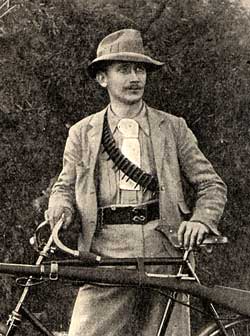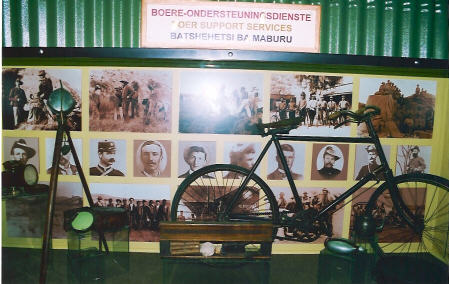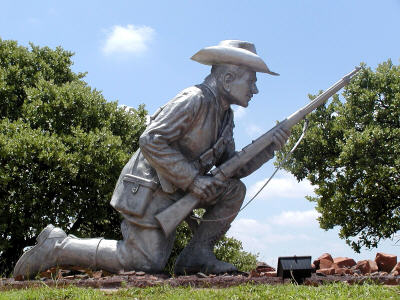
 |
|
|
What is remembered of the Boer War is the hardship of a people, their struggle for freedom, their braveness, their iron will - and their heroes.
Daniel Johannes Stephanus Theron was one of them. Born in Tulbagh, Cape Colony, on 9th May 1872, Danie Theron had to learn to accept responsibility and stand on his own two feet as of an early age. At the age of just 10 he had
to leave his birthplace to be brought up by his older half brother in Bethlehem in the Free State. From there he went on to Middleburg, Kaap, Rouxville and Cape Town, were he, in 1889, earned his exam to be a schoolteacher. He
worked as a teacher in Nooitgedacht and the Soutpansberg district until he, in 1893, took up a position as a clerk in a lawyers firm in Pietersburg. Becoming a lawyer for the people became his new objective - which he reached in
1897 when he passed his exam in Pretoria with the highest possible marks. In the same year he started his own law firm in Krugersdorp. It was here and through his profession that he, for the first time, got nationwide attention.
But not as a lawyer defending another person. Danie Theron was found guilty for assaulting a Mr WF Moneypenny, the editor of The Star
newspaper. Moneypenny has been in South Africa for less than two months and has written a derogatory editoral against “The Ignorant Dutch”, which brought the blood of Danie Theron, a patriot and supporter of the independant
Transvaal, to a boil. In court, on Tuesday, 25th April 1899, Danie Theron pleads extreme provocation. His fine of GBP 20,00 was quickly paid by supporters in the courtroom. |
|
|
||||||||||||||||||||||||||||||||||||||||||
Danie Theron´s first encounter with military action was in 1894 when he was called up for a commando in the Malaboch war. He fought bravely for the Transvaal and was awarded citizenship for his actions. |
Prior to the outbreak of the Boer War Danie Theron developed the idea of using bicycles for despatch and reconnaissance work in the military. Britain, Australia and New
Zealand all were operating bicycle corps for despatch purposes - but Theron´s idea went further. With his friend J.P. (Koos) Jooste, a cycling champion, Theron asked the Transvaal Government to allow them to raise a cycling
corps. His notion was to use bicycles were ever possible in order to save horses for actual combat. During a meeting with President Kruger and Commandant-General Piet Joubert it was decided that a race between Jooste on a bicycle
and a horse rider should answer all open questions. Jooste won the 75 km race from Pretoria to the Crocodile River and permission was given to Danie Theron to form the Wielrijders Rapportgangers Corps. |
He immediately started to advertise in newspapers in and around Johannesburg and Pretoria for young men to join his corps. Trusted friends and followers were sent out
to select reliable and able young men from the ranks of the upper classes. Soon Danie Theron´s Wielrijders Rapportgangers Corps consisted of 108 men and was divided into seven sections. Each section was led by a lieutenant directly
reporting to Theron. On 9th September 1899 those sections were sent out to different districts to perfom their tasks. Waterberg, Soutspansberg, Lichtenburg, Wakkerstroom, Vryheid, Zeerust and Bloemfontein welcomed the men of the
newly founded corps. Each man was supplied with a bicycle, trousers (shorts), a revolver and sometimes a light rifle. Before the actual outbreak of hostilities the cyclists were used for a number of tasks: patrolling the
Swaziland border, “spying”, carrying despatches and functioning as a link between commandos. Although many of the burghers at first looked down on the Rapportgangers Corps, they soon changed their minds as a result of the
bravery and successful exploits of Danie Theron´s men - they could not be stopped by rivers, heavy roads or enemy patrols. At the battle of Talana (Dundee) Danie Theron´s charge was responsible for most of the 246 British prisoners
that were captured that day. |
 |
|||||
Danie Theron as Commandant of the Wielrijders Rapportgangers Corps in 1899 |
|||||
 |
|||||
The “Danie Theron Section” in the Boer War Museum, Bloemfontein |
|||||
At Paardeberg, General P.A. Cronje was rounded up by Lord Roberts and in battle since 18th February, when General de Wet developed a plan for Cronje´s releave and survival. As it was impossible to communicate with Cronje through the British lines, de Wet sent his best man to cross the lines and enter the boer laager in an effort to co-ordinate a break-out of Cronje´s men. Danie Theron bravely crossed the British lines mostly crawling and swam through the flooded Moder River to reach General Cronje on 25th February 1900. He stayed with Cronje and tried to convince him of the plan to attack the British trenches in full force, while de Wet rides a cavalry attack from the other side of the British lines. Cronje rejected the plan. On Tuesday 27th February, Majuba Day, Danie Theron returned to General de Wet. Two hours after Theron´s return, on the 10th day of the Battle of Paardeberg, General Cronje and 3.919 men surrendered to Lord Roberts. |
In General de Wet´s own words: “.......Danie Theron, that famous captain of despatch-riders, had
arrived the previous day with reinforcements. I asked him if he would take a verbal message to General Cronje - I dare not sent a written one, lest it should fall into the hands of the English. Proud and destinct the answer came at
once - the only answer which a hero such as Danie Theron could have given: “Yes, General, I will go.” The risk which I was asking him to run could not have been surpassed throughout the whole of our sanguinary
struggle. I took him aside and told him that he must go and tell General Cronje that our fate depended upon the escape of himself and the thousands with him, and that, if he should fall into the enemy´s hands, it would be the
death-blow to all our hopes. Theron was to urge Cronje to abandon the laager, and everything contained in it, to fight his way out by night, and to meet me at two named places, where I would protect him from the pursuit of the
English. Danie Theron undertook to pass the enemy´s lines and to deliver my message. He started on his errand on the night of the 25th of February. The following evening I went to the place of meeting, but to my great
disappointment General Cronje did not appear. On the morning of the 27th of February Theron returned. He had performed an exploit unequalled in the war. Both in going and returning, he had crawled past the british sentries, tearing
his trousers to rags during the process. The blood was running from his knees, where the skin had been scraped off. He told me that he had seen the general, who had said that he did not think that the plan which I had proposed had
any good chance of success. By ten o´clock that day, General Cronje surrendered. Bitter was my disappointment. Alas! my last attempt had been all in vain. The stubborn General would not listen to good advice.” |
|
|
In March 1900 General de Wet appointed Danie Theron to establish his own commando of scouts: “Theron se Verkenningskorps (TVK)” (Theron Reconnaissance Corps) Danie Theron was allowed to freely recruit and organise men of his choice from the forces of both Boer Republics. General de Wet once said that he never saw a more colourful bunch of men from all over the world than the TVK. The corps consisted of around 80 men on horses and concentrated on reconnaissance and guerilla attacks. |
Patience was not one of Commandant Danie Theron´s virtues. He asked a lot of himself and his men and was known for his tough but fair style of leadership. Although his men feared his short fuse, they respected his honesty and looked up to his strategic superiority. They followed him to hell and back. He led the TVK to a number of still talked about feats. |
|
|
||||||||||||||||||||||||||||||||||||||||||||||||||||||||||||||||||||||||||||||||||||||||||||||||||||||||||||||||||||||||||||||||||||||||||||||||||||||||||||||||||||||||||||||||||||||||||||||||||||||||||||||||||||||||||||||||||||||||||||||||||||||||||||||||||||||||||||||||||||||||||||||||||||||||||||||||||||||||||||||||||||||||||||||||||||||||||||||||||||||||||||||||||||||||||||||||||||||||||||||||||||||||||||||||||||||||||||||||||||||||||||||||||||||||||||||||||||||||||||||||||||||||||||||||||||||||||||||||||||||||||||||||||||||||||||||||||||||||||||||||||||||||||||||||||||||||||||||||||||||||||||||||||||||||||||||||||||||
In the Gatsrand, Commandant Danie Theron plans an attack on General Hart´s column. While scouting alone on a koppie, about 6 kilometres north of present-day Fochville, he almost collides with seven members of Marshall´s Horse. He is forced to fire and kills three and wounds four. He keeps up a terrific volume of fire, presumably trying to give the impression of a far larger force. The columns escort, alerted by the firing, immediately charges the hill. The lone scout continues firing and the column´s artillery - six field guns and a 4,7 inch naval gun - open a heavy barrage on the hill. The legendary Republican hero is killed in an inferno of lyddite and shrapnel. (Taken from “The Anglo-Boer-War, a Chronology” by Pieter G. Cloete) |
|
|
||||||||||||||||||||||||||||||||||||
On 15th September 1900, the men of the TVK exhume the body of their brave Commandant and rebury him in the family cemetry of the Pienaar family near Fochville. On
10th March 1903, Danie Theron´s last will was carried out. His body was once again exhumed to be reburied next to that of his beloved late fiancée Hannie Neethling on her father´s farm Eikenhof on the Klip River. The great hero has
returned to the love of his life. On 28th December 1907, Generals Botha and Smuts unveiled the great Danie Theron Monument near Potchefstrom - never to be forgotten by the people he gave his life for. |
On 6th March 2002, former President Nelson Mandela unveiled the new Danie Theron Monument near the Union Building in Pretoria. It was one of the very
rare occassions where Mr. Mandela spoke Afrikaans in public. In his speech the former President valued the fighting spirit of Danie Theron, his honesty, bravery and his determination to do the right thing for his nation and his
believes. In his strive for a better South Africa and in dying for his believes Danie Theron is a hero for all south africans. Nelson Mandela said that the modern South Africa needs more Danie Therons in order to meet the
challenges that lie ahead. |
 |
Danie Theron Statue unveiled by Nelson Mandela at Fort Schanskop in Pretoria. The statue has been moved from the “Danie Theron Combat School” in Kimberley, after its closure in 2001. |
|
|
|
||||||||||||||||||||
In 2003 the grave of Danie Theron on Neethingshof Cemetery in Eickenhof was vandalized, his remains taken and the iron fencing toppled. Investigation by the police resulted in the arrest of a couple that is believed to have taken the remains in conjunction with witchcraft believes. Whether the remains of the Boer War Hero have been returned to his grave is not known to the author. |
|
|
||||||||||||||||||||||||||||||||||||||||||||